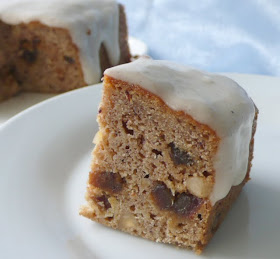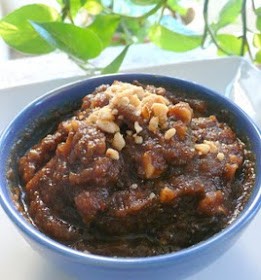 |
| Chutney in a cake |
Dan Lepard's recipe for
Tamarind and Date Cake which appeared in
The Guardian in April intrigued me. I love anything with dates in it, and while I also love the sourness of
tamarind, I couldn't imagine how it would work in a cake.
But after studying the recipe, I realised there's really not a lot of it – only 50g – so there would be a nice tang as from lemon juice, but because it is a paste, that would add moistness to the cake.
Later, I reviewed Carol Selva Rajah's
Malaysian Cooking (here's the
published article and here's the
post on it) which has a recipe for Sweet Tamarind Date Chutney.
We were doing preserves and pickles for the
July edition of Don't Call Me Chef, and thinking of how to use the chutney, I remembered Dan Lepard's cake. So I thought why not combine the two – there are dates and tamarind paste in the cake recipe, and the chutney contains dates and tamarind, so it wouldn't be weird at all.
Except for the fact that the chutney also has chilli, fennel and mustard seeds in it.
Well, you might think that the cake would taste odd with those "non-cake" spices, but it really doesn't. The people I offered the cake to all had more than one slice and they liked the fact that it wasn't overly sweet nor too dense from too many dates. And they certainly didn't say anything about tasting the spices.
I used Dan Lepard's recipe as a guide, but only followed the spirit of it. The chutney on its own was very good and I wanted to put a bit more than 50g of it into the cake so had to experiment with the amounts of the other ingredients.
Cakes made by the melting method – where the wet ingredients are cooked gently on the stove (as Dan Lepard has done) and blended before the dried ingredients are added – are wonderfully moist and keep better. Usually cakes made with butter by the creaming method turn to stone when stored in the refrigerator, but because the butter in this cake is melted, that doesn't happen. Instead of cooking on the stove, the butter in my cake melts from the heat of the boiling water added to the dates to soften them. That's one less step to handle.
I have to say that when I offered the cake to my colleagues, it was unfrosted. I only decided to add Dan Lepard's cardamon-flavoured icing a day later because it is an unusual one and since I didn't use a lot of sugar in the cake, I thought it could handle some sweetness on the top. Biting into a cardamom pod in a curry or briyani isn't the most pleasant thing, but the ground seeds in the lemon-flavoured icing do add another level to this cake.
Also, I didn't have enough unsalted butter so had to include about 4 tablespoons of salted butter. This cake must have been destined for success – the extra salt didn't hurt it. If only I were as lucky with my other experiments.
TAMARIND DATE CHUTNEY CAKE
150g chopped dates
150g tamarind date chutney (recipe follows)
150g unsalted butter, softened
75g dark brown sugar
2 medium eggs
275g plain flour
2 tsp bicarbonate of soda
100g hazelnuts, toasted and roughly chopped
150g icing sugar
The seeds from 6-8 cardamom pods, finely ground
Juice of ½ lemon
- Line the base and sides of an 18cm deep cake tin with non-stick baking paper; grease paper. Preheat the oven to 180°C. Put the dates in a mixing bowl with 150ml boiling water to soften. Stir in the butter until melted; set aside to cool, 10 minutes.
- Add the chutney and brown sugar, stir well then beat in the eggs until smooth. Sift in the flour and soda and mix to blend. Stir in the nuts. Spoon into the tin and bake for about an hour, turning the tin around halfway through, or until a skewer poked in comes out clean. Leave to cool completely on a wire rack.
- Remove from tin and ice it, if desired, or cover with foil and store in the refrigerator overnight. To make icing, mix the icing sugar, cardamom, juice and a little water if needed, to a thick smooth icing and spoon this over the cake so it dribbles down the sides. This cake is best eaten the next day.
PRINTABLE RECIPE
 |
| Jolly good dip |
SWEET TAMARIND DATE CHUTNEY
Makes 1 cup
150g chopped pitted dates
2 tsp fennel seeds, dry-roasted and ground to a powder
1-2 tsp chilli powder, or to taste
75g seedless tamarind pulp (asam jawa), mixed with 1 cup water
2-3 tbsp palm sugar or dark brown sugar
Salt, to taste
1 tbsp oil
½ tsp mustard seeds
35g chopped toasted hazelnut, optional
- Purée the dates, fennel seed powder, red pepper, tamarind juice, sugar and salt in a food processor. Heat the oil in a pan and stir-fry the mustard seeds over high heat until they pop, 1-2 mins. Add the purée and bring to a boil, stirring constantly until the chutney becomes thick, 2-3 mins. Reduce the heat to low and simmer uncovered for 2 mins. When the chutney has a dropping consistency, stir well and remove from the heat. Mix through the nuts, if using. To store, cool and keep in a sealed jar in the refrigerator for a week.
PRINTABLE RECIPE





